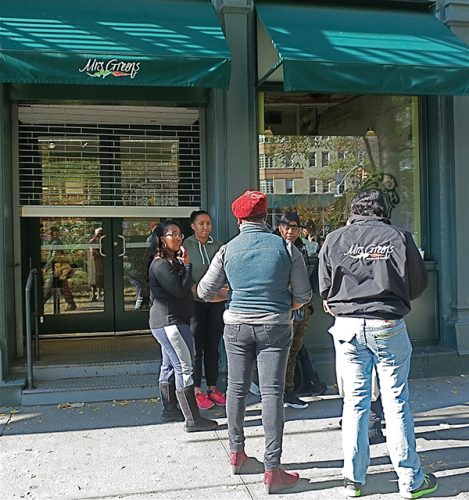By Andrew Buemi
Where there’s smoke, there’s fire.
Recent supply shortages and limited “winter hours” at Mrs. Green’s, located on the corner of Hudson and Bank Streets, have had local customers and store employees alike wondering if the store would be closing.
Those worries were confirmed in mid-November when Mrs. Green’s announced that it would indeed be shuttering its West Village location, in addition to its stores in Rye and Tarrytown, New York and those in Stamford and Fairfield, Connecticut. The company also announced that CEO Pat Brown has stepped down; the existing management team has taken over as they search for Brown’s replacement.

A press release issued by Mrs. Green’s attributed the store closures and the management shakeup to a new “strategic focus on five core Westchester stores,” adding that, “while the closure of any location is difficult…they are also necessary as we focus on our core, profitable stores.” The five remaining stores, which have also experienced severe supply shortages, are located in Yorktown Heights, Briarcliff, Mt. Kisco, Eastchester, and Larchmont.
The Larchmont-based organic grocer has had a tumultuous two-year run in the Village. After signing a 20-year lease at 585 Hudson Street for a reported $2 million in 2013, Mrs. Green’s opened in 2014 only to be met with picket lines and protests from an influential labor union, the United Food & Commercial Workers International Union (Local 1500). The union had been involved in a series of labor disputes with Mrs. Green’s since 2013, when a number of employees at the grocer’s Mt. Kisco location lost a petition for a union election. The National Labor Relations Board charged the grocer with violating federal labor laws, including illegal interrogation and intimidation of employees ahead of their vote to form a union.
Mrs. Green’s business philosophy is one that many expected to flourish in a world increasingly focused on health and wellness: small stores, organic and locally-sourced products, on-staff nutritionists, and 10% off for seniors on Wednesdays. The store also offered its employees—referred to as “associates”—compensation packages including profit sharing and bonuses. But in a City where grocery stores face continuous challenges—from astronomical rents to slim profit margins and increasing competition—some industry experts are not surprised to see the store close.
David Livingston, a grocery store research analyst, said stores like Mrs. Green’s are closing because they do not provide the consumer with a compelling shopping experience. “If they can’t run with the big dogs like Whole Foods, they have to stay on the porch,” he said.
The New York Association of Grocery Stores, a lobbying group which supports the small business model, echoed that sentiment, noting that larger chains like Trader Joe’s and Whole Foods—coupled with the City’s “extremely aggressive” regulatory regime—have put pressure on smaller grocers.
The parent company of Mrs. Green’s, Natural Markets Food Group, which is owned by Canadian private equity firm Catalyst Capital Group, has also been experiencing supply shortages at its Canadian chain, Planet Organic. Calls to Catalyst Capital by WestView News were not returned.
A spokesman for Mrs. Green’s said that, while the landlord has been cooperative throughout the closing process, there’s no indication of who will take over the space at 585 Hudson.
With the string of flops occupying the ground-floor retail space of 99 Bank Street (which abuts 585 Hudson)—including two restaurants that failed to take off (the Marrow and the Missing Ingredient)—we can only hope for a more sustainable tenant that makes sense for the neighborhood residents. (See Allyn Freeman’s suggestions on page 26 of this issue.)



